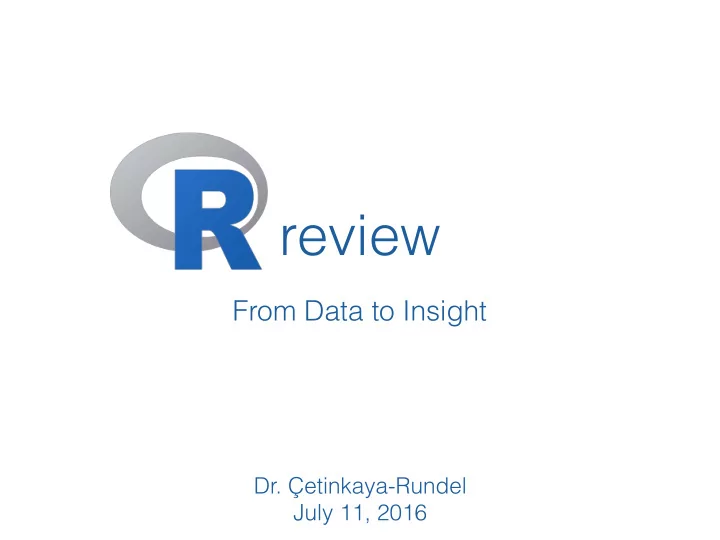

review From Data to Insight Dr. Çetinkaya-Rundel July 11, 2016
Terminology ‣ R: statistical programming language ‣ RStudio: front-end software for R that allows you to organize your files and plot, keeps a history of your command, and provides an environment for creating reports with R Markdown ‣ It’s much more than that, but for our purposes, this should be a sufficient definition ‣ R Markdown: Authoring format for dynamic documents including your R code and your write-up 2
R Markdown ‣ R code goes in chunks, marked by three backticks and the letter r in curly braces to begin and three backticks to end ‣ Within a chunk # is used to mark a comment, any text following this sign on the same line will not get processed as code. ‣ Interpretations, i.e. your write-up “in English”, goes outside of R chunks 3
← input ← output 4
Independent environments ‣ Your Console uses one working environment ‣ Your R Markdown document uses a different (independent) working environment ‣ If you define an object in your Console, but do not define it in your R Markdown document, you will get an error when you try to knit your document saying that the object is not found 5
6
Deciphering errors ‣ This is a skill you’ll develop over time, so do not get discouraged if initially the errors seem too cryptic ‣ Approach deciphering what the error is saying methodically — you don’t need to understand everything printed in the error to figure out what the issue is ‣ First see which line of code is causing the error, noting that the error will point you to the first line of the R chunk ‣ Go to that chunk to see if you can figure out what the issue is (maybe spelling error?) ‣ Read the error further to see if there are other clues like “object not found” or “could not find function” etc. 7
Common erros in code ‣ Spelling! ‣ Spelling of objects you create as well as spelling of functions ‣ Non-matching parantheses and quotation marks 8
ggplot2 ( + ) dplyr ( %>% ) ‣ ggplot2 : Package we are using for plotting ‣ Plots are comprised of layers ‣ Layers are separated by + ‣ Stylistic requirement: End lines of ggplot2 code with + , move to the next line for the next layer ‣ dplyr : Package we are using for data wrangling ‣ Pipes is comprised of chains ‣ Lines of chains are separated by %>% ‣ You read a pipe as take the output of the preceding line and use it as the first argument of the next line ‣ Stylistic requirement: End lines of dplyr code with %>% , move to the next line for the next step in the chain 9
Recommend
More recommend